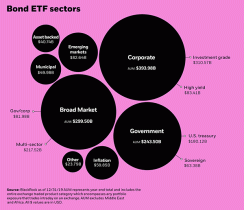Once opaque and difficult to access, the global bond market has transcended long-standing perceptions, transformed by one of the great disruptors in any sector of the global economy – fixed income exchange-traded funds (ETFs).
An ETF is a collection of securities that often seeks to track a market index, and in the case of bond ETFs it’s a collection of bonds that trades on an exchange intraday. Bond ETFs first appeared on the scene in 2002, and the ease, efficiency, and transparency with which they could be traded stood in stark contrast to long-held views of bonds.
Investors soon realized that speed and operational efficiency weren’t the only benefits of bond ETFs. Because they offer exposure to a variety of broad and precise markets or sectors, bond ETFs can play the traditional role of an investment building block, or be part of highly-customized strategies. By the end of 2019, investments in bond ETFs globally stood at nearly $1.2 trillion.1

Cross-sector versatility: Another factor in growth
At the current point in their evolutionary journey, bond ETFs now allow investors access to nearly every type of investment on the fixed income spectrum. Corporate bonds are a mainstay, of course, but as an example of the expanded reach of bond ETFs, asset-backed bond ETFs have reached nearly $41 billion in AUM as investors have increasingly considered securitized credit in the quest for yield. Emerging market bond ETFs have roughly twice that amount in AUM (and represent the fastest growing sector of bond ETFs over the past 10 years, with a compound annual growth rate of 38%)2, and municipal bond ETFs have nearly $50 billion in AUM.3
This growth story indicates that investors see the potential benefits of bond ETFs, and whether they are pursuing low risk, high yield, or a happy medium, various sector bond ETFs can help shape a core or nuanced fixed income strategy.
Look out for $2 trillion
While it took 17 years for bond ETF AUM to reach $1 trillion globally, BlackRock projects it will take far less time for bond ETF assets to reach $2 trillion – something the firm anticipates will happen by 2024. Part of the growth can be attributed to investors’ growing adoption of bond ETFs. According to recent Greenwich Associates research, over 60% of institutional investors used bond ETFs in 2019, up from 20% in 2017.4
Four long-term trends have led BlackRock to project bond ETFs will continue to grow – and rapidly, with AUM expected to exceed $2 trillion by 2024.
First among these trends is an evolution in portfolio construction. No investor is truly passive, and many investors are actively using bond ETFs to seek a variety of outcomes as they construct their portfolios. A second trend riding alongside the first is that institutional investors are increasing their use of bond ETFs because the funds allow them to quickly and efficiently access markets. Two other trends are also linked – a modernizing bond market, with changes in bond trading protocols and technology having profound implications for fixed income markets and portfolio construction; and the ongoing development of new bond ETF exposures which could allow even further customization by investors.
With investors of every stripe coming around to the utility of bond ETFs – whether it’s to diversify asset class exposure, or pursue income or yield – it would indeed be surprising if the use of bond ETFs doesn’t continue at an electrifying pace.
Download the Full Institutional Guide to ETFs.
Click here for more information on iShares.
1 Source: BlackRock as of 12/31/19. AUM represents year-end total and include the entire exchange-traded product category, which encompasses any portfolio exposure that trades intraday on an exchange. AUM excludes Middle East and Africa. All $ values are in USD.
2 Source: BlackRock, compound annual growth rate based on data from 12/31/09 to 12/31/19.
3 Source: BlackRock as of 12/31/19. AUM represents year-end total and include the entire exchange-traded product category, which encompasses any portfolio exposure that trades intraday on an exchange. AUM excludes Middle East and Africa. All $ values are in USD.
4 Source: 9th Annual Greenwich Associates Institutional ETF Study, 2019. Based on 181 U.S. respondents respectively. Usage figure come from a survey of asset manager, insurer, consultants, and institutional funds.
Carefully consider the Funds' investment objectives, risk factors, and charges and expenses before investing. This and other information can be found in the Funds' prospectuses or, if available, the summary prospectuses which may be obtained by visiting www.iShares.com or www.blackrock.com. Read the prospectus carefully before investing. Investing involves risk, including possible loss of principal.
Fixed income risks include interest-rate and credit risk. Typically, when interest rates rise, there is a corresponding decline in bond values. Credit risk refers to the possibility that the bond issuer will not be able to make principal and interest payments Non-investment-grade debt securities (high-yield/junk bonds) may be subject to greater market fluctuations, risk of default or loss of income and principal than higher-rated securities.
International investing involves risks, including risks related to foreign currency, limited liquidity, less government regulation and the possibility of substantial volatility due to adverse political, economic or other developments. These risks often are heightened for investments in emerging/developing markets and in concentrations of single countries.
When comparing stocks or bonds and iShares Funds, it should be remembered that management fees associated with fund investments, like iShares Funds, are not borne by investors in individual stocks or bonds.
Buying and selling shares of ETFs may result in brokerage commissions. There can be no assurance that an active trading market for shares of an ETF will develop or be maintained.
The strategies discussed are strictly for illustrative and educational purposes and are not a recommendation, offer or solicitation to buy or sell any securities or to adopt any investment strategy. There is no guarantee that any strategies discussed will be effective. The information presented does not take into consideration commissions, tax implications, or other transactions costs, which may significantly affect the economic consequences of a given strategy or investment decision.
The iShares Funds are distributed by BlackRock Investments, LLC (together with its affiliates, “BlackRock”). BlackRock is not affiliated with Institutional Investor, LLC.
iSHARES and BLACKROCK are registered trademarks of BlackRock. All other marks are the property of their respective owners.
ICRMH0220U-1086370







